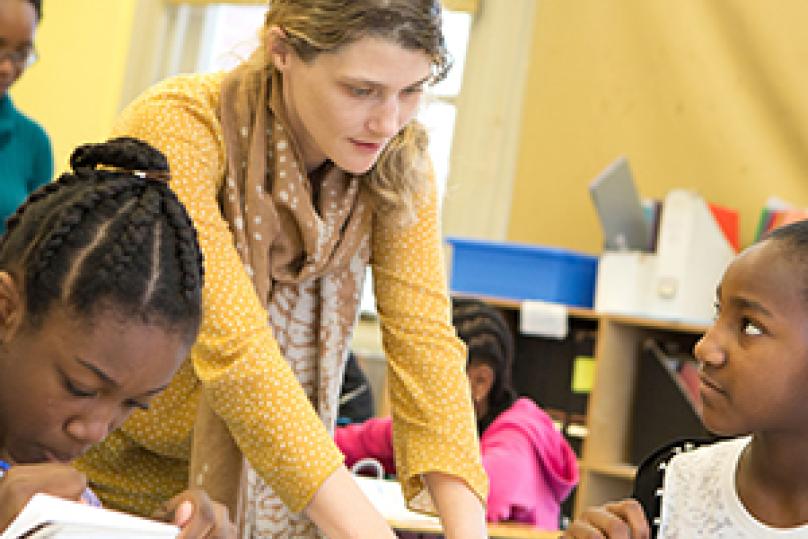
By Marcelle Good, MƒA Master Teacher
As a math teacher, I should be thrilled by Mayor de Blasio’s school reforms centered on equity and excellence. As part of his reforms, the mayor promises an “Algebra for All” program in which all students will do algebra by ninth grade, and all will have access to algebra in eighth grade. Instead, I dread the implementation, because the mayor and I have a radically different understanding of what equity means.
Equity means that everyone gets what they need. Equality means everyone gets the same thing.
Here’s a helpful visual. While the mayor’s plan recognizes that all students are not the same – the plan includes extra support for struggling students in the form of algebra prep classes – he is treating all schools the same. Furthermore, I’m concerned that he is wildly underestimating how far below grade level many students are. My fear is that the students who struggle the most will only get superficial grade-level supports, rather than the deep interventions they will need for math to make sense to them in high school and beyond.
In the name of equality – not equity – students across the city have been taught grade-level content every year, regardless of what they have learned before. Year after year, as teachers scramble to give students a fighting chance to pass a standardized test, they expose students to as much grade-level content as they can. And students fall farther and farther behind. To do anything differently would be to deny students equal access to rigorous content. I don’t blame teachers for that; the system demands this approach.
I spent my first years teaching with the mistaken belief that all of my students should do as much of the grade-level content as they could. Looking back, this stance was ludicrous. I worked at an international high school for newcomers, so while many students could handle the work, I had many others with limited formal education. Can you imagine the injustice of requiring that a 17-year-old ninth-grader, newly arrived from Tibet, who had almost no formal education take the same course in algebra as every other ninth grader in New York?
Now that I teach in East New York, even though most of my students have been attending New York City schools since kindergarten, I am facing the same challenges as before. Most of my students enter sixth grade reading and doing math at a second- or third-grade level.
My school responds to these challenges by trying to figure out what students know and building on their skills from there. When students are struggling with subtraction skills they should have mastered in second grade, I no longer hand them a calculator and hope for the best – I teach them to subtract. In my classroom, I am devoting less time to sixth-grade curriculum that my students aren’t ready for, and spending far more time shoring up the concepts they missed in elementary school, because if they do not have those building blocks, they will never be able to understand algebra. What is happening is not surprising – my students are learning faster and catching up to their grade-level peers.
Teaching for equity means we acknowledge that students have different needs, we find out what those needs are, and we meet them.
This should not be radical. But somewhere along the way – probably when we started talking about not leaving children behind – we started ignoring what they needed and giving them all the same thing. This does not mean that some children are less capable than others, it means that the system is more broken than an algebra prep class can fix. Schools in New York City are more segregated than anywhere else in the country. Poor people and people of color have wildly different educational experiences here than their wealthier, whiter peers. We need to acknowledge that in order to change it.
So, what can be done? First, listen to the best advice out there. The Organisation for Economic Co-operation and Development published a brief in 2008 with 10 steps to equity in education. The group recommended that school systems identify and provide systematic help to those who fall behind at school and direct resources to students with the greatest needs. The mayor’s plan hints at this by providing all schools support, but it will not be enough for schools serving the city’s neediest students. Until schools in New York are desegregated, we need to fund schools equitably – that is unequally – so that schools serving the students who need the most are getting the most resources. (More on our segregated schools here and here.)
The millions of dollars for citywide professional development for Algebra for All won’t help the teacher with a class of 34 fifth-graders who are still struggling with second-grade math. That teacher needs 14 fewer students, and training on how to develop flexible teaching strategies to ensure students are building on what they already know when they are doing math.
We need better assessment tools so that teachers can figure out where their students are. Then we give schools more resources to support students in meeting their social and emotional needs. Until we are responding to those needs, our students will fall further behind.
We need policymakers to do more than just say the word equity and then follow that up with a plan that reaches all students the same way. That is how we got here to begin with.
Instead, we need to do something truly radical: We need to start giving appropriate and equitable, not equal, resources to schools and the freedom to meet students where they are.
